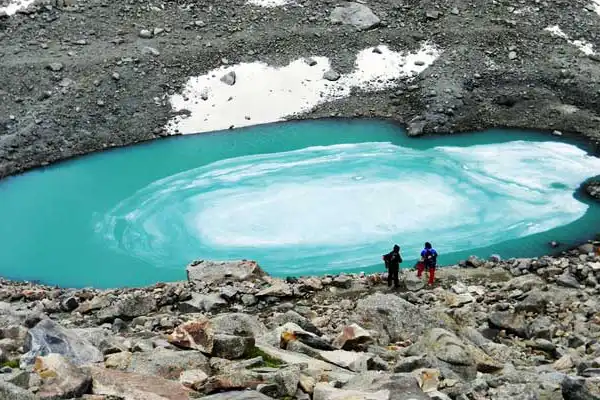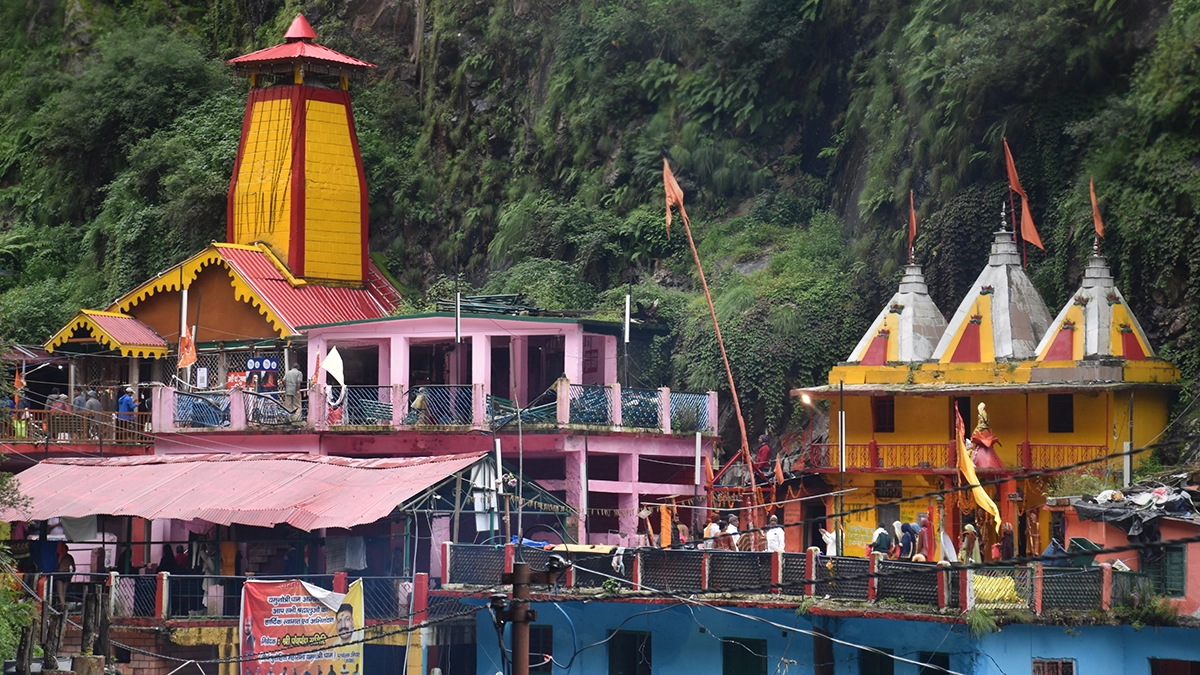Tucked up in the Himalayas of Uttrakhand, Kedarnath Dham is among the twelve Hindu sacred Jyotirlinga pilgrimage sites. It is one of the significant temples in the Char Dham Yatra, which comprises Badrinath, Gangotri, and Yamunotri. Apart from being a pilgrim town, Kedarnath Dham is popular for its stunning location. Every year, thousands of devotees traverse a strenuous trek of the Kedarnath Yatra to get the divine blessings of Lord Shiva at the Kedarnath Temple.
It is an ancient Hindu temple with stunning architecture built from heavy, large, and uneven grey stone slabs. A conical rock in the temple premises is worshiped as Lord Shiva in his “Sadashiva” form. At the backside of the Kedarnath temple are Kedarnath Peak, Kedar Dome, and many other Himalayan mountain peaks that add beauty to this stunning temple. Let’s understand more about the Kedarnath Temple and other essential details.
Kedarnath Dham Overview

At 3583 meters above sea level, Kedarnath Dham is nestled among the towering mountains of the Garhwal Himalayas. Kedarnath Temple is indeed one of the most beautiful temples of ancient India. After the flood in 2013, the temple is still rebuilding, and new features, including helipads and guest houses, have been added. Online booking services make it easier to access Kedarnath Puja by ensuring that worshippers can make the bookings easily and complete their preferred puja.
So, the morning rituals begin daily at 4:00 a.m., starting with the Maha Abhishek. Then, at 7:00 p.m., the puja ends with Shyam Aarti. The temples are available only for six months, then closed for the next six months during winter. To reach Kedarnath Dham, one has to cross some very tough terrains, but simultaneously, the feeling is divine. Normally, people begin their Kedarnath Yatra from Gaurikund, the last motorable point, a 16 km trek. From picturesque views to waterfalls and lush greenery, this trek provides spiritual satisfaction and satisfies the eye.
History of Kedarnath Dham

Numerous myths and legends narrate the history of Kedarnath Dham yatra. According to history, the Pandavas from the Hindu epic Mahabharata constructed the temple to seek penance for the sins incurred during the war. Lord Shiva attempted to hide, transforming himself into a bull and then going under the ground, leaving back his hump visible. At that point, they constructed the Kedarnath Temple. Similarly, other parts of Lord Shiva are said to have emerged at four other places, and people belt on them as eleven incarnations of Lord Shiva. The arms of the Lord emerged at Tungnath, the belly for Madmaheshwar, the face to Rudranath, and his locks (hair) for Kalpeshwar. So, these five temples complete the Panch Kedar Circuit.
Adi Shankaracharya, a great philosopher and theologian who contributed to the rebirth of the Hindu religion in India, constructed the current Kedarnath Temple in the 8th century CE. Its construction in the rocky terrains of the Himalayas is remarkable and shows how the people, with their wisdom of that time, managed to build such a magnificent structure.
Kedarnath Dham has weathered several disasters over the centuries, including landslides and floods, that have not shaken the people’s faith and devotion. The floods in 2013 heavily impacted the region. However, the temple remained standing, and now the Government is trying to reconstruct the structures.
Kedarnath Yatra Registration
Let’s understand the Kedarnath Yatra registration process. The Uttarakhand government has made registration mandatory to address the challenge and guarantee the safety of pilgrims in Kedarnath. Pilgrims have the option to complete the registration either online or offline. Without registration, you can’t avail of the Chardham Yatra by Helicopter services.
Online Registration
To register, the pilgrims must go through the official website or download the application. The process entails entering information such as name, dates of travel, and other travel companions and uploading ID and medical certificate. Upon completion of the registration, the pilgrims get a Yatra registration slip, which they must carry during the pilgrimage. The verification will be done at the shrine.
For online registration, pilgrims can follow any of these steps:
- Visit the https://registrationandtouristcare.uk.gov.in/ website, complete the signup process, and proceed with the Kedarnath Yatra registration process. You must fill in the travel dates, name, number of pilgrims, contact number, and the necessary documents to complete the registration process.
- If you are not using this website, you can complete the registration process by downloading the Tourist Care Uttarakhand app on your iOS or Android Device.
- Besides this, you can complete the Yatra using WhatsApp by sending the message “Yatra” to the number 8394833833.
Offline Registration
If an individual wants to register offline, Pilgrims can locate registration centers in different areas within Haridwar, Rishikesh, and Sonprayag regions. Pilgrims must show their photo ID and other essential documents to complete the Kedarnath Yatra registration process and receive the Yatra registration slip. They need to carry this slip to the temple.
Verification is possible physically only at the shrine being visited after scanning the “QR Code” in the mobile application or downloading the “Yatra Registration Letter.”
Best time to Visit Kedarnath

The ideal time of year to visit Kedarnath is during the summer season, which is May and June, and then between September and October. These periods provide better climate and weather conditions than the rest of the year and lower risks for trekking. Vaayu Aviation offers the best Chardham Packages for a comfortable travel experience.
The temple officially opens from the last week of April to the first week of May, which marks the Yatra season. The climate is moderately warm during these months, and the average temperatures fluctuate between 5°C and 18°C. The sky is clear, and many flowers enhance the majesty of the roads, making this journey even more exciting. So, this makes it the best time to visit the Kedarnath Yatra.
The temperature remains quite low after the monsoon season,; hence, September to October is also suitable for traveling to this region. The post-monsoon times make the scenery even greener and the views of the Himalayas clearer. The mountain climate is cool, even during the Indian summer. The climate prevailing in this region is cold as it marks the onset of winter. Due to snowfall and very cold weather, the temple remains closed for six months, from November to April. The deity of Lord Shiva is shifted to Ukhimath, and the deity is taken up for puja during the winter season.
The monsoon season is not ideal for Kedarnath Yatra. There is a high possibility of exceedingly high rainfall in the area, and this has implications of causing landslides, short floods, and difficult terrains when trekking. Hence, this is an unsafe time for pilgrims, especially due to natural disasters associated with the rainy season.
Places to Visit Near Kedarnath
Apart from Kedarnath Temple, the main shrine, there are many other spiritual and natural places of interest in the area that are worth visiting. So after your Kedarnath Yatra, consider visiting these places:
1. Vasuki Tal

Vasuki Tal is a high-altitude glacial lake located approximately 8 km from Kedarnath. The path to the lake is quite steep, and after the trek, one gets to see the majestic peaks of Chaukhamba along with the calm and still waters of the Lake. Moreover, this is among the most preferred destinations for trekkers and those interested in adventure and exploration of natural landmarks.
2. Gaurikund

Gaurikund, which serves as the starting point of the trek to Kedarnath shrine too, is sacred. As per mythology, this is the site where Parvati performed penance to please Lord Shiva and win his love. Gaurikund has hot water spring and it is a belief that taking a bath here provides relief from sickness and disease.
3. Bhairav Temple

Bhairav Temple is located near the Kedarnath Temple. The temple is devoted to Bhairav Nath. Also, it is believed that Bhairav Nath is the deity who guards the Kedarnath Temple and the region.
4. Triyuginarayan Temple

Situated 25 km away from Kedarnath, Triyuginarayan is famous for the Akhanda Jyoti, which, according to Hindu mythology, has been burning since Lord Shiva married Goddess Parvati. Hence, during your Kedarnath Yatra, you can consider visiting the temple.
5. Sonprayag

Sonprayag lies at the confluence of the Mandakini and Basuki rivers. It is a popular stopping place for the Kedarnath yatra, and there are nice views of mountains and rivers nearby.
Things to Know Before You Visit Kedarnath
1. Physical Fitness
The route to Kedarnath Yatra is quite strenuous and involves a certain amount of rigor, so one should be fit to undertake this kind of journey. In the months leading up to the visit, pilgrims should take part in some form of exercise and perhaps build their stamina. It is also recommended that they visit a doctor and get a medical certificate.
2. Acclimatization
Because of the high altitude, it is crucial that one takes some days to get used to the altitude in order not to fall sick. If necessary, one can spend some time either at Gaurikund or Sonprayag, etc., to acclimatize on the way to the Holy abode.
3. Packing Essentials
Pilgrims should pack lightly for the Kedarnath Yatra. However, they should ensure that they take items like warm clothing, comfortable trekking shoes, a raincoat, a first aid box and any necessary medicines. Other essentials include high-energy snacks, water bottles, and flashlights.
4. Weather Conditions
The climate in the Himalayas is very unpredictable. Hikers should be ready for drastic weather changes and take necessary equipment to protect them from cold, wind, or rain. It is also important to know about the weather conditions.
5. Permits and Registration
Carrying the Kedarnath Yatra registration slip, medical certificate, and photo ID is compulsory throughout the journey.
6. Local Customs and Etiquette
Adhere to cultural norms wherever you are. A pilgrim should dress appropriately, observe modesty and hygiene, and ensure no litter is left behind. It is also important not to cause discomfort to the locals or other pilgrims through our conduct.
7. Emergency Services
Some medical facilities may be available along the route, but they might not be extensive. Pilgrims should take and have a small first aid set and be knowledgeable on the whereabouts of medical support. Traveling in groups and keep communicating with friends and family is advisable.
Frequently Asked Questions
Q1). Can I visit Kedarnath Dham without Registration?
No, Registration is Mandatory for the Kedarnath Dham Yatra as well as the Chardham Yatra.
Q2). Are phones allowed in Kedarnath Dham?
The Uttarakhand government has banned the use of mobile phones within a 200-meter radius of the Kedarnath, Badrinath, Yamunotri, and Gangotri temple in Uttarakhand, India.
Q3). Is it safe to go to Kedarnath by Car?
It is advisable to have a well-maintained vehicle that can handle rough, hilly areas.
Q4). How many hours to complete the trek of Kedarnath Dham?
It takes up to 6-8 hr to complete the trek of Kedarnath Yatra from Gaurikund.
Q5). How many people can sit in the helicopter?
6 people can sit in a Helicopter.




